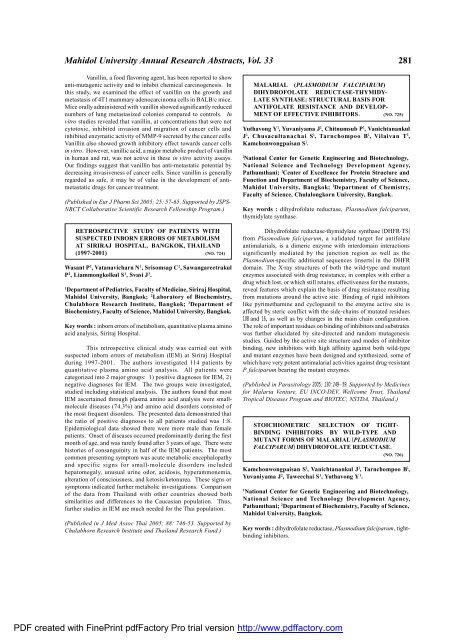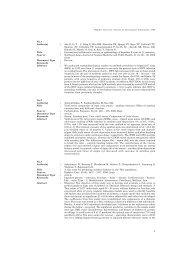Faculty of Science - Mahidol University
Faculty of Science - Mahidol University
Faculty of Science - Mahidol University
You also want an ePaper? Increase the reach of your titles
YUMPU automatically turns print PDFs into web optimized ePapers that Google loves.
<strong>Mahidol</strong> <strong>University</strong> Annual Research Abstracts, Vol. 33 281<br />
Vanillin, a food flavoring agent, has been reported to show<br />
anti-mutagenic activity and to inhibit chemical carcinogenesis. In<br />
this study, we examined the effect <strong>of</strong> vanillin on the growth and<br />
metastasis <strong>of</strong> 4T1 mammary adenocarcinoma cells in BALB/c mice.<br />
Mice orally administered with vanillin showed significantly reduced<br />
numbers <strong>of</strong> lung metastasized colonies compared to controls. In<br />
vitro studies revealed that vanillin, at concentrations that were not<br />
cytotoxic, inhibited invasion and migration <strong>of</strong> cancer cells and<br />
inhibited enzymatic activity <strong>of</strong> MMP-9 secreted by the cancer cells.<br />
Vanillin also showed growth inhibitory effect towards cancer cells<br />
in vitro. However, vanillic acid, a major metabolic product <strong>of</strong> vanillin<br />
in human and rat, was not active in these in vitro activity assays.<br />
Our findings suggest that vanillin has anti-metastatic potential by<br />
decreasing invasiveness <strong>of</strong> cancer cells. Since vanillin is generally<br />
regarded as safe, it may be <strong>of</strong> value in the development <strong>of</strong> antimetastatic<br />
drugs for cancer treatment.<br />
(Published in Eur J Pharm Sci 2005; 25: 57-65. Supported by JSPS-<br />
NRCT Collaborative Scientific Research Fellowship Program.)<br />
RETROSPECTIVE STUDY OF PATIENTS WITH<br />
SUSPECTED INBORN ERRORS OF METABOLISM<br />
AT SIRIRAJ HOSPITAL, BANGKOK, THAILAND<br />
(1997-2001) (NO. 724)<br />
Wasant P 1 , Vatanavicharn N 1 , Srisomsap C 2 , Sawangareetrakul<br />
P 2 , Liammongkolkul S 1 , Svasi J 3 .<br />
1 Department <strong>of</strong> Pediatrics, <strong>Faculty</strong> <strong>of</strong> Medicine, Siriraj Hospital,<br />
<strong>Mahidol</strong> <strong>University</strong>, Bangkok; 2 Laboratory <strong>of</strong> Biochemistry,<br />
Chulabhorn Research Institute, Bangkok; 3 Department <strong>of</strong><br />
Biochemistry, <strong>Faculty</strong> <strong>of</strong> <strong>Science</strong>, <strong>Mahidol</strong> <strong>University</strong>, Bangkok.<br />
Key words : inborn errors <strong>of</strong> metabolism, quantitative plasma amino<br />
acid analysis, Siriraj Hospital.<br />
This retrospective clinical study was carried out with<br />
suspected inborn errors <strong>of</strong> metabolism (IEM) at Siriraj Hospital<br />
during 1997-2001. The authors investigated 114 patients by<br />
quantitative plasma amino acid analysis. All patients were<br />
categorized into 2 major groups: 1) positive diagnoses for IEM, 2)<br />
negative diagnoses for IEM. The two groups were investigated,<br />
studied including statistical analysis. The authors found that most<br />
IEM ascertained through plasma amino acid analysis were smallmolecule<br />
diseases (74.3%) and amino acid disorders consisted <strong>of</strong><br />
the most frequent disorders. The presented data demonstrated that<br />
the ratio <strong>of</strong> positive diagnoses to all patients studied was 1:8.<br />
Epidemiological data showed there were more male than female<br />
patients. Onset <strong>of</strong> diseases occurred predominantly during the first<br />
month <strong>of</strong> age, and was rarely found after 3 years <strong>of</strong> age. There were<br />
histories <strong>of</strong> consanguinity in half <strong>of</strong> the IEM patients. The most<br />
common presenting symptom was acute metabolic encephalopathy<br />
and specific signs for small-molecule disorders included<br />
hepatomegaly, unusual urine odor, acidosis, hyperammonemia,<br />
alteration <strong>of</strong> consciousness, and ketosis/ketonurea. These signs or<br />
symptoms indicated further metabolic investigations. Comparison<br />
<strong>of</strong> the data from Thailand with other countries showed both<br />
similarities and differences to the Caucasian population. Thus,<br />
further studies in IEM are much needed for the Thai population.<br />
(Published in J Med Assoc Thai 2005; 88: 746-53. Supported by<br />
Chulabhorn Research Institute and Thailand Research Fund.)<br />
MALARIAL (PLASMODIUM FALCIPARUM)<br />
DIHYDROFOLATE REDUCTASE-THYMIDY-<br />
LATE SYNTHASE: STRUCTURAL BASIS FOR<br />
ANTIFOLATE RESISTANCE AND DEVELOP-<br />
MENT OF EFFECTIVE INHIBITORS. (NO. 725)<br />
Yuthavong Y 1 , Yuvaniyama J 2 , Chitnumsub P 1 , Vanichtanankul<br />
J 1 , Chusacultanachai S 1 , Tarnchompoo B 1 , Vilaivan T 3 ,<br />
Kamchonwongpaisan S 1 .<br />
1 National Center for Genetic Engineering and Biotechnology,<br />
National <strong>Science</strong> and Technology Development Agency,<br />
Pathumthani; 2 Center <strong>of</strong> Excellence for Protein Structure and<br />
Function and Department <strong>of</strong> Biochemistry, <strong>Faculty</strong> <strong>of</strong> <strong>Science</strong>,<br />
<strong>Mahidol</strong> <strong>University</strong>, Bangkok; 3 Department <strong>of</strong> Chemistry,<br />
<strong>Faculty</strong> <strong>of</strong> <strong>Science</strong>, Chulalongkorn <strong>University</strong>, Bangkok .<br />
Key words : dihydr<strong>of</strong>olate reductase, Plasmodium falciparum,<br />
thymidylate synthase.<br />
Dihydr<strong>of</strong>olate reductase-thymidylate synthase (DHFR-TS)<br />
from Plasmodium falciparum, a validated target for antifolate<br />
antimalarials, is a dimeric enzyme with interdomain interactions<br />
significantly mediated by the junction region as well as the<br />
Plasmodium-specific additional sequences (inserts) in the DHFR<br />
domain. The X-ray structures <strong>of</strong> both the wild-type and mutant<br />
enzymes associated with drug resistance, in complex with either a<br />
drug which lost, or which still retains, effectiveness for the mutants,<br />
reveal features which explain the basis <strong>of</strong> drug resistance resulting<br />
from mutations around the active site . Binding <strong>of</strong> rigid inhibitors<br />
like pyrimethamine and cycloguanil to the enzyme active site is<br />
affected by steric conflict with the side -chains <strong>of</strong> mutated residues<br />
108 and 16, as well as by changes in the main chain configuration.<br />
The role <strong>of</strong> important residues on binding <strong>of</strong> inhibitors and substrates<br />
was further elucidated by site-directed and random mutagenesis<br />
studies. Guided by the active site structure and modes <strong>of</strong> inhibitor<br />
binding, new inhibitors with high affinity against both wild-type<br />
and mutant enzymes have been designed and synthesized, some <strong>of</strong><br />
which have very potent antimalarial activities against drug -resistant<br />
P. falciparum bearing the mutant enzymes.<br />
(Published in Parasitology 2005; 130: 249–59. Supported by Medicines<br />
for Malaria Venture, EU INCO-DEV, Wellcome Trust, Thailand<br />
Tropical Diseases Program and BIOTEC, NSTDA, Thailand .)<br />
STOICHIOMETRIC SELECTION OF TIGHT-<br />
BINDING INHIBITORS BY WILD-TYPE AND<br />
MUTANT FORMS OF MALARIAL (PLASMODIUM<br />
FALCIPARUM) DIHYDROFOLATE REDUCTASE.<br />
(NO. 726)<br />
Kamchonwongpaisan S 1 , Vanichtanankul J 1 , Tarnchompoo B 1 ,<br />
Yuvaniyama J 2 , Taweechai S 1 , Yuthavong Y 1 .<br />
1 National Center for Genetic Engineering and Biotechnology,<br />
National <strong>Science</strong> and Technology Development Agency,<br />
Pathumthani; 2 Department <strong>of</strong> Biochemistry, <strong>Faculty</strong> <strong>of</strong> <strong>Science</strong>,<br />
<strong>Mahidol</strong> <strong>University</strong>, Bangkok.<br />
Key words : dihydr<strong>of</strong>olate reductase, Plasmodium falciparum, tightbinding<br />
inhibitors.<br />
PDF created with FinePrint pdfFactory Pro trial version http://www.pdffactory.com
















